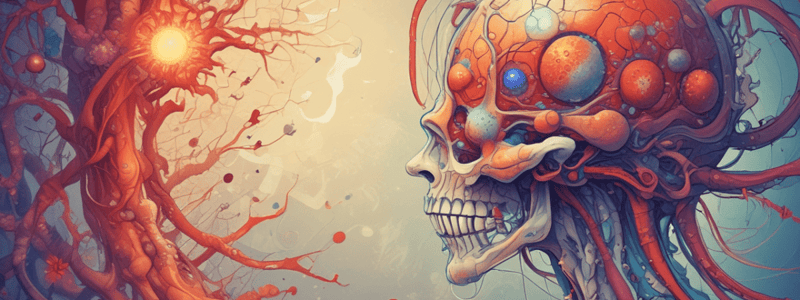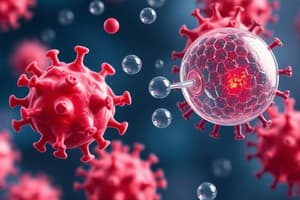Podcast
Questions and Answers
What is the source of plasma-derived chemical mediators in inflammation?
What is the source of plasma-derived chemical mediators in inflammation?
- Synthesized de novo
- Released from mast cells
- Circulating precursors (correct)
- Sequestered intracellularly
What is the effect of histamine on arterioles and venules?
What is the effect of histamine on arterioles and venules?
- Dilation of arterioles and contraction of venular endothelium (correct)
- Constriction of both arterioles and venules
- Dilation of arterioles and constriction of venules
- Constriction of arterioles and dilation of venules
What is the function of serotonin in inflammation?
What is the function of serotonin in inflammation?
- Increasing vascular permeability
- Suppressing the inflammatory response
- Causing vasoactive effects similar to histamine (correct)
- Promoting platelet aggregation
How are cell-derived chemical mediators produced?
How are cell-derived chemical mediators produced?
What is the result of increased vascular permeability in acute inflammation?
What is the result of increased vascular permeability in acute inflammation?
Where is histamine typically found?
Where is histamine typically found?
What is the primary function of prostaglandins produced via the cyclooxygenase pathway?
What is the primary function of prostaglandins produced via the cyclooxygenase pathway?
Which of the following is NOT a product of the lipoxygenase pathway?
Which of the following is NOT a product of the lipoxygenase pathway?
What is the primary effect of platelet activating factor (PAF) on platelets?
What is the primary effect of platelet activating factor (PAF) on platelets?
What is the primary mechanism by which reactive oxygen species (ROS) eliminate bacteria?
What is the primary mechanism by which reactive oxygen species (ROS) eliminate bacteria?
What is the primary effect of nitric oxide on blood vessels?
What is the primary effect of nitric oxide on blood vessels?
What is the primary function of arachidonic acid (AA) metabolites in the context of the immune response?
What is the primary function of arachidonic acid (AA) metabolites in the context of the immune response?
What is the primary function of cytokines and chemokines in the immune system?
What is the primary function of cytokines and chemokines in the immune system?
Which of the following cells are the primary producers of cytokines and chemokines?
Which of the following cells are the primary producers of cytokines and chemokines?
What is the effect of cytokines and chemokines on endothelial cells?
What is the effect of cytokines and chemokines on endothelial cells?
What is the role of neuropeptides in the immune system?
What is the role of neuropeptides in the immune system?
What is the function of chemokines such as CXCL-8/IL8 and MCP-1?
What is the function of chemokines such as CXCL-8/IL8 and MCP-1?
Which of the following is a systemic effect of cytokines and chemokines?
Which of the following is a systemic effect of cytokines and chemokines?
Which type of inflammation is characterized by the exudation of cell-poor fluid from plasma or secretions of mesothelial cells?
Which type of inflammation is characterized by the exudation of cell-poor fluid from plasma or secretions of mesothelial cells?
What is the primary component of the fluid in fibrinous inflammation?
What is the primary component of the fluid in fibrinous inflammation?
What is the outcome if fibrinous exudates are not removed?
What is the outcome if fibrinous exudates are not removed?
What is the characteristic of pus in purulent inflammation?
What is the characteristic of pus in purulent inflammation?
What is the outcome of the conversion of fibrinous exudate to scar tissue?
What is the outcome of the conversion of fibrinous exudate to scar tissue?
What is the characteristic of an abscess?
What is the characteristic of an abscess?
What is a characteristic feature of ulcer formation?
What is a characteristic feature of ulcer formation?
Which of the following is a common site for ulcer formation?
Which of the following is a common site for ulcer formation?
What is a characteristic of catarrhal inflammation?
What is a characteristic of catarrhal inflammation?
What is a characteristic feature of pseudomembranous inflammation?
What is a characteristic feature of pseudomembranous inflammation?
What is a common site for the formation of peptic ulcers?
What is a common site for the formation of peptic ulcers?
What is a common consequence of tissue necrosis and inflammation?
What is a common consequence of tissue necrosis and inflammation?




